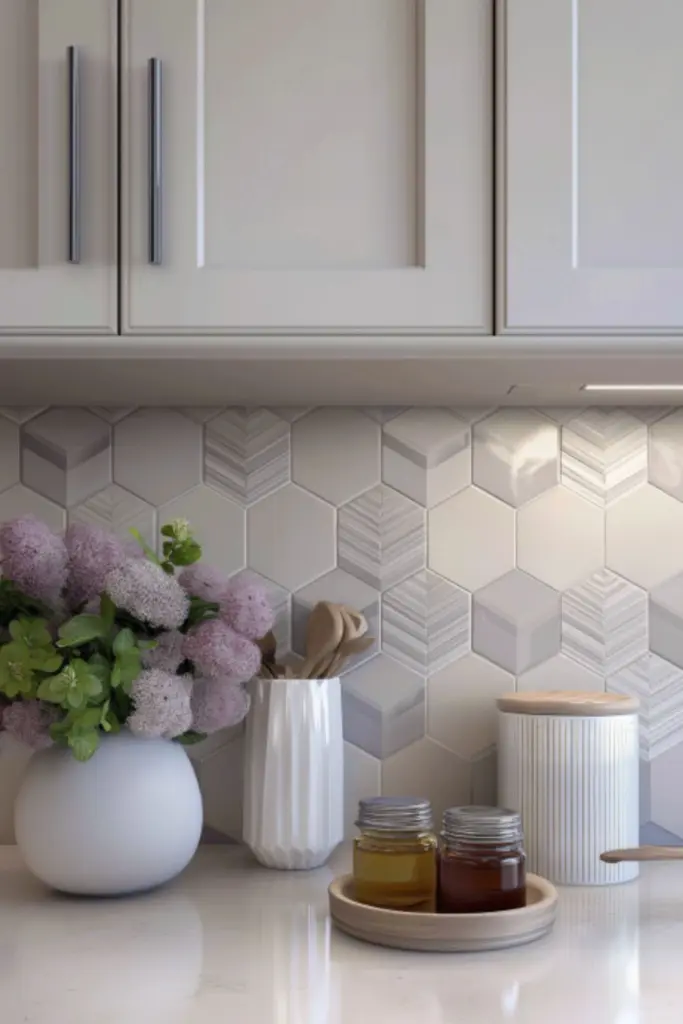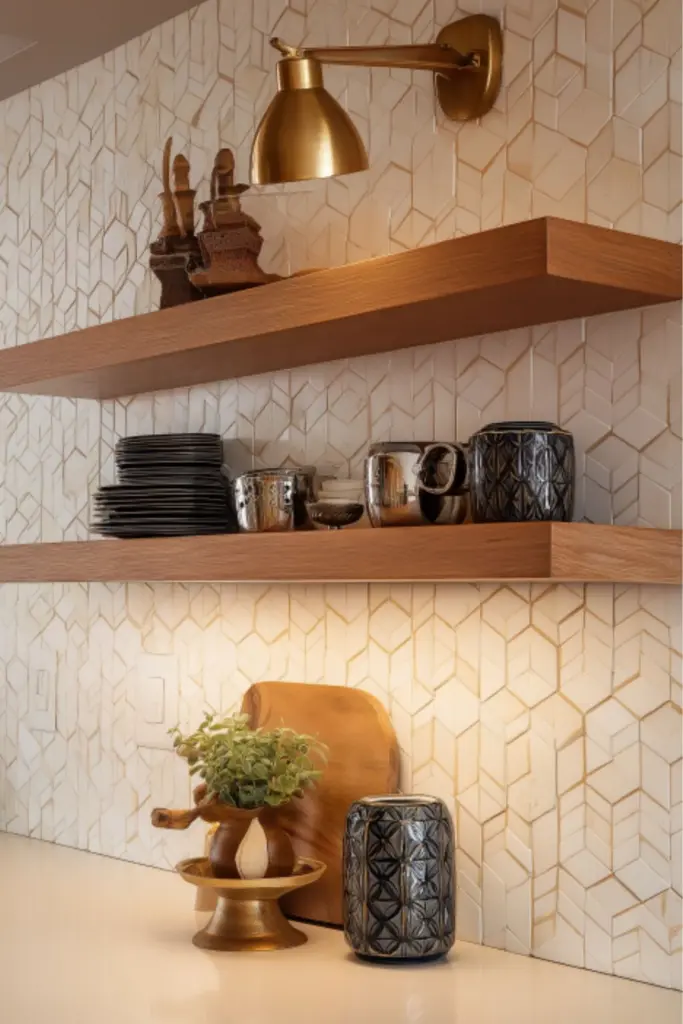Geometric Kitchen Backsplash Designs That Add Visual Interest and Style
Table of Contents
Ever walked into a kitchen and felt instantly drawn to the backsplash? That’s the power of a well-chosen design. In fact, 64% of homeowners say a statement backsplash is one of the top upgrades that increase kitchen appeal — and when geometric patterns are involved, the visual interest multiplies.
Utilizing geometric kitchen backsplash designs can transform a simple kitchen into a stylish showpiece. These eye-catching shapes—hexagons, chevrons, triangles, quatrefoils—play with light, add dimension, and tie together cabinetry, countertops, and decor. Beyond aesthetic charm, they provide a practical, easy-to-clean surface perfect for daily use.
In this post, we’ll explore a range of geometric backsplash ideas that add visual interest and suit various kitchen styles—from minimalist modern to warm traditional. You’ll learn about tile materials, pattern selection, installation tips, accent integration, small-space adaptation, and budget-friendly options. Whether you’re planning a full remodel or a weekend refresh, these evergreen ideas will help you craft a kitchen backsplash that stands the test of time.
Choosing the Right Tile Material for Your Geometric Backsplash

When planning a geometric backsplash, the tile material determines both the look and longevity of your design. Popular choices include ceramic, porcelain, glass, and natural stone. Each material brings unique advantages and aesthetic nuances to your geometric pattern.
Ceramic is budget-friendly and available in countless colors and finishes, making it ideal for large-scale geometric shapes like rectangles or octagons. Porcelain is denser and more durable, perfect for high-moisture areas and intricate shapes like arabesque or fish scale. Glass reflects light beautifully, adding brightness to your geometric backsplash but may require careful maintenance. Natural stone such as marble or travertine introduces organic texture and classic warmth, especially when cut into hexagons or mosaics.
Consider gloss versus matte finishes to match your style—glossy tiles highlight contrast and light, while matte offers subtlety and sophistication. To accommodate grout lines in tiny geometric shapes, choose tiles with rectified edges (precision-cut). This allows for thinner grout lines and a cleaner, more modern look.
Tile Material Comparison Table
| Material | Pros | Cons | Best Shapes |
|---|---|---|---|
| Ceramic | Affordable, versatile | Less durable than porcelain | Rectangles, squares, hexagons |
| Porcelain | Waterproof, durable | Higher cost, harder to cut | Intricate shapes, arabesques |
| Glass | Reflective, brightens space | Shows smudges, pricier | Small mosaics, watercolors |
| Natural stone | Organic texture, timeless appeal | Porous, needs sealing | Hexagon, split face mosaics |
Picking the Perfect Geometric Pattern for Visual Impact

Selecting the pattern is where the fun starts. Your geometric shapes determine the visual energy of the backsplash—whether it’s calm and structured or dynamic and playful.
Hexagon tiles create honeycomb grids that feel modern yet organic. Chevron or herringbone patterns offer motion and directionality. Triangles or diamond shapes can form complex mosaics reminiscent of Moroccan or encaustic designs. Quatrefoil or Moroccan-inspired lantern motifs add intricate elegance and cultural flair. Even simple stacked rectangles, when installed offset or vertically, offer crisp, contemporary lines.
Large patterns suit open, minimalist kitchens, while smaller repeats work well in compact or traditional spaces. Depth is achieved by combining matte and glossy finishes or mixing subtle color tones—like pairing cream with soft gray in a staggered layout.
Geometric Layout Inspiration
| Pattern Type | Visual Effect | Ideal Kitchen Style |
|---|---|---|
| Hexagon | Balanced, modern organic | Contemporary, farmhouse chic |
| Chevron | Directional motion, lively pattern | Transitional, mid‑century |
| Triangle | Bold, graphic, mosaic-style | Eclectic, global, modern |
| Quatrefoil | Soft curves, intricate detailing | Traditional, boho or Mediterranean |
| Stacked tile | Clean, contemporary linear look | Minimalist, loft-style kitchens |
Installation Tips to Accentuate Geometric Designs

Installing geometric tile demands precision and planning—but with the right approach, it’s a straightforward path to visual interest. Begin with meticulous layout planning: dry-lay tiles on a board or clean surface to test alignment and balance across outlets or lighting. Use templates for intricate patterns like triangles or herringbone to maintain consistent grout spacing.
Choose grout color wisely—matching grout blends tiles into a unified surface, while contrasting grout defines each shape. In hexagon or triangle patterns, grouting may shift, so lightly apply and clean quickly to maintain edges.
Tile spacers make consistent lines essential in geometric layouts. Flexible mosaic sheets, common with hexagon or penny tile, simplify placement, but you may need to remove backing for complex shapes like arabesques.
For corners or outlet cutouts, use a wet saw with diamond blade. Fit pieces tightly; precise cuts make for sleek finishing lines. Seal porous tiles (e.g., stone) before grouting to prevent staining. Once installed, wipe the surface of tiles to remove haze and avoid residue settling in grout lines, which can dull the crisp geometry.
Installation Process Checklist
| Step | Purpose | Tip |
|---|---|---|
| Dry-lay layout | Check symmetry and edge alignment | Use temporary spacers and chalk lines |
| Choose grout | Defines or blends shapes | Match tile for subtle, contrast for defined |
| Install tile | Follow pattern carefully | Start center, move outward |
| Cut edge tiles | Fit against cabinets/outlets | Wet saw ensures crisp precision |
| Clean and seal | Preserve finish and protect surfaces | Wipe haze off before grout fully dries |
Accent Integration: Enhancing Geometry with Color and Texture

A geometric backsplash is a statement, but accents help define and elevate it. Combine the tile with complementary cabinetry, countertops, and hardware to enhance visual interest.
For example, brass or matte black hardware picks up on the tile outlines, emphasizing angles and corners. Wooden open shelving introduces organic warmth against structured shapes. Recessed lighting or under-cabinet LED strips highlight the backsplash texture and deepen shadow contrast.
Countertops—whether marble, concrete, or butcher-block—should harmonize with tile colors. Subtle tone-on-tone contrast keeps the aesthetic soothing and allows geometry to stand out. In bold patterns, calm countertops prevent over-stimulation.
Even small decorative accents—like a kettle, olive oil dispenser, or spice jars—can echo tile hues and reinforce the geometry visually. Keep these elements minimal to avoid competing with your backsplash design.
Complementary Accent Guide
| Accent Area | Suggested Material/Color | Styling Function |
|---|---|---|
| Cabinet hardware | Matte black or brass | Defines edges and adds polish |
| Counters | Neutral quartz, concrete, light stone | Grounds bold tile without clashing |
| Shelving | Warm wood like walnut, oak | Softens geometric rigidity |
| Lighting | LED wing for texture highlight | Illuminates patterns and shapes |
| Decor accents | Glassware, jars, textiles in coordinating hues | Ties backsplash into the overall vibe |
Geometric Backsplash in Small Kitchens
Small kitchens can benefit from geometric backsplashes—patterned tiles add depth and style without taking up real estate. To make geometry work in confined spaces, follow strategies that enhance rather than overwhelm.
Choose light-colored tiles—soft whites, pale grays, pastels—to keep the kitchen airy. Smaller shapes like mini hexagons or micro triangles can add texture without overpowering the scale. For dramatic flair, use full backsplash height up to the ceiling to draw eyes upward and visually expand the space.
Consider a monochromatic palette so shapes form subtle depth rather than bold contrast. Grout can be matched to tile for cohesion, or slightly contrasted for dimension. In ultra-small spaces, offset a patterned backsplash with sleek, handleless cabinets—less visual clutter lets geometry shine.
Reflective materials—glass or polished porcelain—brighten the backsplash. Paired with under-cabinet LEDs or a skylight, these tiles can make compact spaces feel open and modern.
Small-Kitchen Optimization Table
| Strategy | Tiles & Design | Effect on Space |
|---|---|---|
| Light tones | White/honeycomb mini hexagon | Maximizes brightness and openness |
| Ceiling-high backsplash | Extends pattern to top of wall | Visually stretches kitchen vertically |
| Monochrome palette | Same-tone tile and grout | Creates spatial unity |
| Reflective tile surface | Glossy porcelain or glass | Enhances light flow and bounce |
| Minimal cabinets | Handleless, seamless cabinetry | Reduces visual interruption |
Rethinking Budget: Affordable Geometric Backsplash Alternatives
You don’t need expensive designer tile to get geometric flair. There are plenty of budget-friendly alternatives that deliver visual impact.
Peel-and-stick vinyl tiles offer temporary geometric patterns—ideal for renters or DIYers. They mimic tile shapes and complement various design styles while being affordable and easy to install.
Another option is mosaic sheets: inexpensive plastic or mesh-mounted tiles in geometric patterns. They’re easy to install and come in glass, ceramic, or stone-look finishes. Even subway tile can be arranged in herringbone or vertical stacked layouts for a geometric-inspired look without specialty tiles.
For a high-end aesthetic on a tight budget, pick a bold accent color for a small backsplash area—such as behind a range—and use subway or plain tiles elsewhere. This creates contrast and visual intrigue without covering the entire wall in costly geometric tile.
Budget Backsplash Options
| Option | Cost Range | Visual Impact | Installation Ease |
|---|---|---|---|
| Peel-and-stick vinyl | Low | Decent pattern mimic | Very easy; renter-friendly |
| Mosaic tile mesh sheets | Moderate | High visual texture | Medium: requires adhesive, grout |
| DIY subway arrangements | Moderate-low | Custom geometric pattern | Standard tile skills |
| Accent tile insert | Low-medium | Targeted visual pop | Balanced cost; scalable installs |
Conclusion
Geometric kitchen backsplash designs are a powerful way to infuse your cooking space with visual interest—even on a small scale. By carefully selecting tile materials, pattern types, grout styles, and complementary finishes, you can craft a backsplash that is uniquely you—whether bold and dramatic or softly understated.
With thoughtful installation, accent integration, and budget-conscious alternatives, geometric backsplashes remain accessible and timeless. They transform kitchens into inviting, stylish environments full of personality and charm. And that’s a recipe worth kitchen bragging rights.

